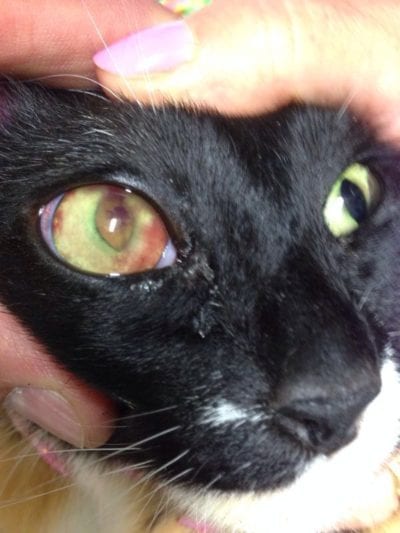
Caring for a cat involves providing it with everything it needs so that it can lead as long a healthy life as possible. But unfortunately it is not enough to give him a good home, a good diet and a lot of love to prevent him from illnesses or accidents.
Microorganisms are always lurking, waiting for the opportunity to enter the body of our dear friend. Although there are some that are more harmless than others, uveitis in cats is one of the most common diseases that should be known to find out what steps to take to help you.
What is it?

Image - Especiesveterinario.com
Uveitis is an eye disease that affects the uveal tract, which is a kind of vascular veil that protects the eyes, lubricating them. Due to its structure, the uvea is very vulnerable to microorganisms; in fact, in severe cases the cat could become partially or totally blind, which is why it is so important to take it to the vet as soon as we detect the symptoms that we will mention below.
What types are there?
There are three types of uveitis depending on the eye region that is being affected:
- Anterior uveitis: mainly affects the iris and ciliary bodies.
- Intermediate uveitis: affects the posterior portion of the ciliary bodies
- Posterior uveitis: affects the choroid, which is an ocular membrane located between the sclera and the retina.
What are the causes?
Uveitis in cats is caused by endogenous factors, that is, a consequence of a lowering of defenses caused by another disease; or exogenous.
Endogenous causes
It is estimated that 70% of the cases of cats suffering from uveitis were caused by the following diseases:
- Feline Infectious Peritonitis Virus (FIP)
- Virus Feline leukemia (FeLV)
- Feline Immunodeficiency Virus or Feline AIDS (FIV)
- Systemic toxoplasmosis
- Systemic mycoses
Exogenous causes
They are associated with accidents, fights or trauma suffered by the cat. Any major injury can cause uveitis.
What are the symptoms?

The symptoms of uveitis in cats are as follows:
- Photophobia: move away from light, or close your eyes to avoid it.
- Excessive tearing: produces a lot of tears to try to keep the eye clean.
- Pain and tenderness in the eye area: When you pet him in that area, he may complain or quickly turn away.
- Myosis: is the constriction of the pupils. You will see that the affected eye has a little more closed than the healthy one.
- Retraction of the eyeball: the eye may be »sunken».
- Occurrence of eye diseasesCataracts, glaucoma or retinal detachment are the most common.
How is it treated?
If you detect any of the symptoms that we have mentioned, you should take him to the vet as soon as possible. Once there, the professional will ask you a series of questions to find out how long the cat has been like this, if it has been in an accident or fight, and if you have noticed any changes in its routine or behavior.
Then will examine your eyes in order to make a reliable diagnosis, and to finish you will be treated. This treatment can be to use corticosteroid and non-corticosteroid anti-inflammatory eye drops that will prevent the disease from worsening, administer analgesics if it feels pain, or intervene surgically if the cat has suffered some trauma and presents perforations in the eye.
What care to give a sick cat?

When the veterinarian has diagnosed your cat with uveitis, in addition to giving him the medicine or medicines that he has recommended, you will have to do everything possible so that the animal can lead a life as normal as possible. Eye diseases often take a long time to heal, even if they are caught early, so you must have patience and, above all, try to make the family atmosphere calm.
Therefore, it doesn't hurt to increase the number of pampering sessions (as long as the furry wants, of course, since it does not have to be overwhelmed), and also that of the days in which a special prize is given, like the chicken or tuna can that you like so much. We all know that a sick person who feels protected and loved recovers much better; the same thing happens with the feline. A cat that has reasons to get ahead, such as a human family that cares about it, will draw strength from wherever it can to stay alive.
But you have to be careful: you don't have to caress him a lot on the face, and less on the part near the eyes since you could hurt him. What's more, to put the eye drops, you must wash your hands before and after in order to avoid possible infections. In this way, you will protect the health of your sick cat.
And with this we are done. As you have seen, uveitis in cats is a disease that can be very serious if not detected early. We hope this article helps you.